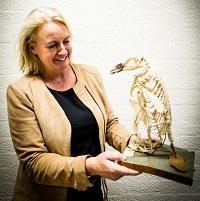She looks around attentively while the curator shows her the collection of shells, stuffed birds and skeletons, animals in strong water, plastic skulls and seaweeds. The objects were (and still are) mainly collected and purchased for teaching within the Ecology course. The course has been offered at the VU since 1950, but the oldest objects date from earlier times, some even from the end of the 19th century. They come from the Artis collection, for example, or were collected by scientists before they came to work at the VU. Knowledge of the collection is slowly diminishing and the origin of many individual objects is unfortunately no longer known.
Jaw of sperm whale
Straetemans is looking for a suitable object to display in the University Library's Heritage display case. "A pink jaw or branch with white points attached to it in a large glass jar attracts attention. It looks like a monster jaw. She considers the monster jaw, (which turns out to be from a sperm whale) because it looks pretty impressive. But to transport and exhibit it, you need a special permit. Moreover, the monster spreads an enormous stench because the pot is damaged. So that's not going to do it. How it ended up at the VU is unclear, as is when and by whom it was taken. It even took some time before someone was found who could identify this monster jaw!
Stuffed birds and skeletons
Then her attention turned to the stuffed birds and bird skeletons. "Those are nice to see." A lot of research was done on birds, especially under professor of animal ecology Karel Voous. He is known for his owl research (on display in the Vitrine of the C0 corridor in the W&N building) and his work for bird protection in the Netherlands and the world.
What will it be now? Will it be the skeleton of the bearded vulture? Or will it be the osprey from 1898? No. Straetemans chooses the blackfooted penguin from 1964. "It has the friendliest appearance, for a skeleton at that. The animal probably lived in Artis, but it is not certain.
